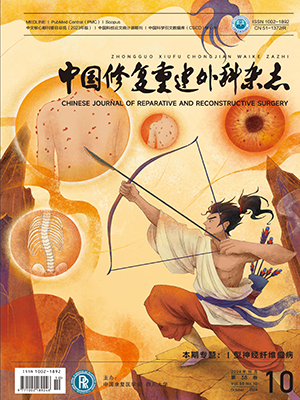| 1. |
Brent B, Ott R. Perichondro-cutaneous graft. Plastic Reconstr Surg, 1978, 62(1): 1-14.
|
| 2. |
Stucker FJ, Walsh WE, Dammert M, et al. The perichondrial cutaneous graft: a facial reconstructive option for the ages (ages 1 week to 94 years). Laryngoscope, 2008, 118(10): 1753-1757.
|
| 3. |
Inchingolo F, Tatullo M, Marrelli M, et al. Clinical case-study describing the use of skin-perichondrium-cartilage graft from the auricular concha to cover large defects of the nose. Head Face Med, 2012, 8: 10.
|
| 4. |
Kalbermatten DF, Haug M, Wettstein R, et al. New posterior auricular perichondrial cutaneous graft for stable reconstruction of nasal defects. Aesthetic Plast Surg, 2005, 29(6): 489-495.
|
| 5. |
Arrigoni SC, Halbersma WB, Grandjean JG, et al. Patients’ satisfaction and wound-site complications after radial artery harvesting for coronary artery bypass. Interact Cardiovasc Thorac Surg, 2012, 14(3): 324-326.
|
| 6. |
Bjertnaes OA, Sjetne IS, Iversen HH. Overall patient satisfaction with hospitals: effects of patient-reported experiences and fulfilment of expectations. BMJ Qual Saf, 2012, 21(1): 39-46.
|
| 7. |
王欣, 王冰, 林格. 面部黑痣的治疗. 中国医药指南, 2008, 6(15): 150-151.
|
| 8. |
李波涛, 安可忍, 李萍, 等. 应用真皮下血管网皮片修复面部皮肤软组织缺损. 中国美容医学, 2011, 20(5): 726-727.
|
| 9. |
Chaiet SR, Marcus BC. Nasal tip volume analysis after butterfly graft. Ann Plast Surg, 2012. [Epub ahead of print].
|
| 10. |
娄跃君, 方柏荣, 王友彬, 等. 耳后真皮脂肪复合组织组织学特点的研究. 中国生物美容, 2009, 9(4): 1-3.
|
| 11. |
高学书, 何清濂, 章惠兰, 等. 我国成年男性30个不同部位的皮肤厚度. 第二军医大学学报, 1980, (3): 96-98.
|
| 12. |
Tomita K, Hosokawa K, Yano K, et al. Dermal vascularity of the auricle: implications for novel composite grafts. J Plast Reconstr Aesthet Surg, 2009, 62(12): 1609-1615.
|
| 13. |
Portuese W, Stucker F, Grafton W, et al. Perichondrial cutaneous graft. An alternative in composite skin grafting. Arch Otolaryngol Head Neck Surg, 1989, 115(6): 705-709.
|
| 14. |
Gloster HM Jr, Brodland DG. The use of perichondrial cutaneous grafts to repair defects of the lower third of the nose. Br J Dermatol, 1997, 136(1): 43-46.
|
| 15. |
Patterson AR, Brady G, Walker PD, et al. The perichondrial cutaneous graft and “flip-flop” flap in facial reconstruction: a series of 41 cases. Br J Oral Maxillofac Surg, 2008, 46(2): 114-118.
|
| 16. |
Almeyda R, van der Eerden P, Vuyk H. Skin graft survival on subcutaneous hinge flaps: an algorithm for nasal reconstruction. Laryngoscope, 2013, 123(3): 605-612.
|
| 17. |
Zampar AG, Salomons RL, Dornelles RF, et al. Chondrocutaneous auricular graft for reconstruction of ocular socket in anophthalmic cavities. J Craniofac Surg, 2011, 22(2): 602-605.
|
| 18. |
van der Eerden P, Simmons M, Zuur K, et al. Full-thickness skin grafts and perichondrial cutaneous grafts following surgical removal of cutaneous neoplasms of the head and neck. Eur Arch Otorhinolaryngol, 2010, 267(8): 1277-1283.
|
| 19. |
Larcher L, Plötzeneder I, Tasch C, et al. Retroauricular pull-through island flap for defect closure of auricular scapha defects—a safe one-stage technique. J Plast Reconstr Aesthet Surg, 2011, 64(7): 934-936.
|
| 20. |
O’Driscoll SW, Fitzsimmons JS. The importance of procedure specific training in harvesting periosteum for chondrogenesis. Clin Orthop Relat Res, 2000, (380): 269-278.
|
| 21. |
Van Osch GJ, Van Der Veen SW, Burger EH, et al. Chondrogenic potential of in vitro multiplied rabbit perichondrium cells cultured in alginate beads in defined medium. Tissue Eng, 2000, 6(4): 321-330.
|
| 22. |
Antohi N, Isac C, Stan V, et al. Dorsal nasal augmentation with “open sandwich” graft consisting of conchal cartilage and retroauricular fascia. Aesthet Surg J, 2012, 32(7): 833-845.
|
| 23. |
Sage RJ, Leach BC, Cook J. Antihelical cartilage grafts for reconstruction of mohs micrographic surgery defects. Dermatol Surg, 2012, 38(12): 1930-1937.
|
| 24. |
Wong VW, Levi K, Akaishi S, et al. Scar zones: region-specific differences in skin tension may determine incisional scar formation. Plast Reconstr Surg, 2012, 129(6): 1272-1276.
|
| 25. |
Suarez E, Syed F, Alonso-Rasgado T, et al. Up-regulation of tension-related proteins in keloids: knockdown of Hsp27, α2β1-integrin, and PAI-2 shows convincing reduction of extracellular matrix production. Plast Reconstr Surg, 2013, 131(2): 158e-173e.
|




